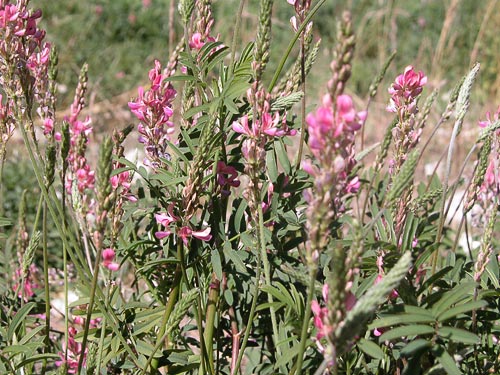Crops
Onobrychis viciifolia Scop. - Sainfoin, St Foin, holy grass.
Taxonomic position.
Family Leguminoseae Endl., genus Onobrychis Mill.Morphology and biology.
2n=24, 28. Pubescent perennial with many erect or sub-erect, hollow stems, 15-90 cm long or more, arising from basal buds on a branched root stock. After defoliation, branches develop from axillary buds on the stem nodes of the remaining stubble. Leaves are pinnate with 5-l4 pairs of obovate leaflets (15-80 mm long) and a terminal leaflet. Stipules broad and finely pointed. Numerous pinkish red flowers, borne in erect, conical racemes, on long axillary stalks. Flowers cross-pollinated, mainly by honey bees; the flattened, indehiscent seed pods contain a single kidney shaped seed, 4-6 mm. Seed color dark olive to brown or black. The root system consists of deep tap root with a few main branches and numerous fine lateral roots bearing most of the rhizobial nodules. Flowers in May-June, seeds ripen in July-August.Distribution.
Introduced into cultivation during the middle of the 14th century. Cultivated on large squares in the forest, steppe and mountainous areas. Cultivated in 117 regions and republics of the former USSR. 26 breeding cultivars have the state permission for utilization.Ecology.
Sainfoin has good drought resistance and grows well on a variety of soils. It does especially well on high lime, well-drained calcareous soils of high fertility. It does not do well on soils that are wet or have a high water table. Excellent drought resistance. Adapted to warm temperate climates. Intolerant to prolonged periods of flooding. Cold winters can reduce plant persistence. High reserves of nitrogen in legume roots during the winter are believed to aid cold hardiness. It is intolerant of acidity and salinity.Utilization and economic value.
Sainfoin is very palatable, and is grazed by livestock in preference to alfalfa. It is reportedly non-bloating. Although very coarse, the herbage is highly nutritious. Compared to alfalfa, forage dry-matter yields of sainfoin are about 20 percent lower under dry-land conditions, and may be at least 30 percent lower in irrigated areas. Responds to irrigation on shallow soils. Condensed tannins in the leaves prevent bloating in ruminants and also improve the efficiency of protein metabolism. The stage of growth is very important during utilization because the food value of this species falls with increased maturity. Sainfoin is protein and mineral rich compared to grasses but its calcium and sodium concentrations are lower than in other major legumes. Sainfoin is a very early-growing legume, and it may tolerate light grazing during the bud stage and still yield a good crop of hay. Forage mass productivity ranges from 15-20 MT/ha, hay productivity ranges from 2.8-5.0 MT/ha and seed productivity is 800-2500 kg/ha. It is an excellent source of nectar and pollen for honey bees.Reference citations:
Catalog of agricultural crop cultivars permitted in Byelorussia. 1985. -Minsk: Uradjai, 176 pp. (in Russian).Catalog of state permitted cultivars of agricultural crops. 1969. -M.: Kolos, 489 pp. (in Russian).
Catalog of state permitted cultivars of agricultural crops. 1971. -M.: Kolos, 488 pp. (in Russian).
Catalog of state permitted cultivars of agricultural crops. 1974. -M.: Kolos, 480 pp. (in Russian).
Catalog of state permitted cultivars of agricultural crops. 1985. -M.: Kolos, V. 3: 489. (in Russian).
Golovkin B.N. 1988. Cultigenic plant area. Moscow: Nauka. 184 pp. (in Russian).
Kashtanov A.N., ed. 1983. The Natural-agricultural regions and utilization of soil resources of the USSR. Moscow: Kolos. 336 pp. (in Russian).
Medvedev P.F., Smetannikova A.I. 1981. The forage crops of European part of the USSR. Leningrad: Kolos. 336 pp. (in Russian).
Shashko D.N. 1967. Agroclimatic region of the USSR. Moscow: Kolos. 335 pp. (in Russian).
Shashko D.N. 1985. Agroclimatic resources of the USSR. Moscow: Kolos. 248 pp. (in Russian).
Soil resources of the USSR (Agricultural regions of areas and republics of USSR). 1990. Moscow: V. 1: 260. (in Russian).
State register of breeding achievements permitted for utilization. Plant cultivars. 1994. -M.: -218 pp. (in Russian).
State register of breeding achievements permitted for utilization. Plant cultivars. 1996. -M.: -171 pp. (in Russian).
State register of breeding achievements permitted for utilization. Plant cultivars. 1999. -M.: -192 pp. (in Russian).
State register of breeding achievements permitted for utilization. Plant cultivars. 2000. -M.: -232 pp. (in Russian).
State register of breeding achievements permitted for utilization. Plant cultivars. 2001. -M.: -252 pp. (in Russian).
State register of breeding achievements permitted for utilization. Plant cultivars. 2003. -M.: -236 pp. (in Russian).
State register of Ukrainian plant cultivars. 1992. -Kiev: Urojai, 199 pp. (in Russian).
The register of plant cultivars in Ukraine. 1996. -Kiev: Urojai, 259 pp. (in Russian).


